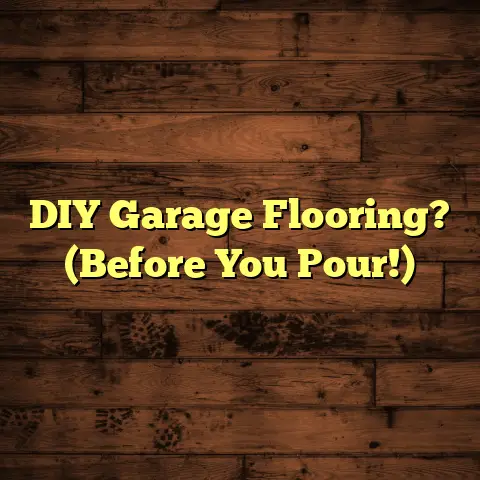Cement Floors For Vinyl Tile? (4 Prep Steps!)
I’m excited to talk about something I’m super passionate about: cement floors and vinyl tile.
When it comes to choosing the “best option” for flooring, it’s like picking your favorite pizza topping – there are so many choices!
But if you’re aiming for that sweet spot of style, durability, and budget-friendliness, then listen up.
Cement floors, my friends, are the unsung heroes, the rock-solid foundation upon which many a beautiful vinyl tile masterpiece has been built.
Vinyl tiles? They’re the chameleons of the flooring world, mimicking everything from wood to stone, all while being easy on the wallet and a breeze to maintain.
Let’s dive into why combining these two is a match made in flooring heaven, and how to prep your cement floor like a pro before you even think about laying down that first vinyl tile.
Section 1: Understanding Cement Floors
So, what are cement floors, exactly?
Well, in the simplest terms, they’re floors made from, you guessed it, cement!
Typically, you’ll find them in residential basements, modern living rooms, and even commercial spaces like warehouses and retail stores.
Why cement? Because it’s tough as nails.
It can withstand a beating, resists moisture (to a degree, more on that later), and adapts well to different climates.
I’ve seen cement floors last for decades with proper care, which is a testament to their inherent strength.
Now, there are different flavors of cement flooring.
You’ve got your polished concrete, which is all sleek and modern, often with a glossy finish that reflects light beautifully.
Then there’s stained concrete, where you can add color and personality to your floor, creating unique patterns and designs.
And of course, there’s the standard concrete slab, the basic foundation that can be transformed into something special with the right treatment.
| Type of Cement Floor | Characteristics | Typical Applications |
|---|---|---|
| Polished Concrete | Glossy, smooth, modern look | Retail spaces, modern homes, showrooms |
| Stained Concrete | Customizable color, unique patterns | Residential homes, restaurants, offices |
| Standard Concrete | Durable, functional base | Garages, basements, industrial settings |
Section 2: The Advantages of Vinyl Tile
Okay, let’s talk vinyl.
These aren’t your grandma’s linoleum floors!
Vinyl tiles have come a long way, offering incredible design versatility and performance.
You’ve probably heard of luxury vinyl planks (LVP) and vinyl composite tiles (VCT).
LVP mimics the look of hardwood floors, complete with realistic grain patterns and textures.
VCT, on the other hand, is a more budget-friendly option often used in commercial settings.
The beauty of vinyl is that it’s incredibly versatile.
Want the look of hardwood without the hefty price tag? Vinyl’s got you covered.
Dreaming of a slate floor in your bathroom but worried about water damage? Vinyl to the rescue!
Plus, it’s comfortable underfoot, easy to clean, and relatively simple to install, even for DIY enthusiasts.
I’ve helped countless homeowners transform their spaces with vinyl, and the results are always stunning.
Section 3: Why Combine Cement Floors and Vinyl Tile?
This is where the magic happens!
Combining cement floors and vinyl tile is like creating a super-flooring duo.
The cement provides a rock-solid foundation, ensuring that your vinyl tiles stay put for years to come.
Think of it as building a house on a strong foundation – the stronger the base, the better the house will withstand the elements.
But it’s not just about stability. Cement also has thermal mass properties, meaning it can absorb and release heat.
This can help regulate indoor temperatures, keeping your home cooler in the summer and warmer in the winter, potentially saving you money on energy bills.
I’ve seen this firsthand in homes with cement subfloors; they tend to be more comfortable year-round.
And let’s not forget the aesthetic potential!
The industrial chic look is all the rage right now, and combining exposed cement with stylish vinyl tiles can create a truly unique and eye-catching space.
Imagine sleek, gray cement floors paired with wood-look vinyl planks in a modern living room – the possibilities are endless!
Section 4: 4 Prep Steps for Installing Vinyl Tile Over Cement Floors
Alright, time to get down to business.
Before you even think about unboxing those vinyl tiles, you need to prep your cement floor.
Trust me, this is the most crucial step in the entire process. Skimp on the prep, and you’ll regret it later.
Step 1: Assessing the Condition of the Cement Floor
First things first, you need to play detective and thoroughly inspect your cement floor.
Look for cracks, even hairline ones.
Check for any signs of moisture, like discoloration or dampness.
And run your hand across the surface to feel for any unevenness or roughness.
Why is this so important?
Because any imperfections in the cement floor will telegraph through to the vinyl tiles, creating an uneven, unsightly surface.
Plus, moisture can wreak havoc on the adhesive, causing the tiles to peel or bubble.
I always recommend using a moisture meter to get an accurate reading of the cement’s moisture content.
Ideally, you want it to be below 3%, as per most vinyl tile manufacturers’ recommendations.
| Condition | Potential Issue | Solution |
|---|---|---|
| Cracks | Uneven surface, potential for tile cracking | Patching compound, crack isolation membrane |
| Moisture | Adhesive failure, mold growth | Moisture barrier, dehumidifier |
| Unevenness/Roughness | Uneven tile installation, poor aesthetics | Leveling compound, grinding |
Step 2: Cleaning the Surface
Once you’ve assessed the condition of the floor, it’s time to get it squeaky clean.
This means removing all dirt, dust, debris, and any previous floor coverings.
I’ve seen some pretty nasty floors in my day, so don’t be afraid to get your hands dirty!
Start by sweeping or vacuuming the entire area.
Then, scrub the floor with a mild detergent and water, using a stiff-bristled brush to remove any stubborn stains or grime.
Rinse thoroughly with clean water and allow the floor to dry completely.
For really tough stains, you might need to use a specialized concrete cleaner.
Just be sure to follow the manufacturer’s instructions carefully and test it in an inconspicuous area first to make sure it doesn’t damage the cement.
Step 3: Repairing and Leveling the Cement Floor
Now comes the fun part – fixing those imperfections!
If you found any cracks during your initial inspection, you’ll need to repair them with a patching compound.
Follow the manufacturer’s instructions for mixing and applying the compound, and be sure to let it dry completely before moving on.
For uneven surfaces, you’ll need to use a leveling compound.
This self-leveling mixture is poured onto the floor and spread evenly with a trowel.
It fills in any low spots and creates a smooth, level surface for your vinyl tiles.
I always recommend using a long, straight edge to check for high and low spots before applying the leveling compound.
This will help you identify any areas that need extra attention.
Step 4: Moisture Barrier and Underlayment Installation
Last but not least, it’s time to protect your investment with a moisture barrier and underlayment.
A moisture barrier is a thin plastic sheet that is laid over the cement floor to prevent water from seeping up and damaging the vinyl tiles.
This is especially important in basements or areas with high humidity.
There are various types of moisture barriers available, so choose one that is specifically designed for use with vinyl tiles.
Be sure to overlap the seams and tape them securely to prevent moisture from seeping through.
Underlayment, on the other hand, provides added cushioning and sound reduction.
It’s a thin layer of foam or cork that is installed between the cement floor and the vinyl tiles.
This can make your floors more comfortable to walk on and reduce noise from footsteps and other sounds.
Again, there are different types of underlayment available, so choose one that meets your specific needs and budget.
Some underlayments even have built-in moisture barriers, which can save you a step in the installation process.
Conclusion
So, there you have it!
Cement floors and vinyl tiles – a match made in flooring heaven.
By following these four prep steps, you can ensure a successful installation that will enhance both the aesthetic and functional qualities of your flooring for years to come.
Remember, the key to a beautiful and long-lasting floor is proper preparation.
Don’t skimp on the prep work, and you’ll be rewarded with a stunning floor that you can be proud of.
So, are cement floors the “best option” for your vinyl tile project? I think so!
With their durability, versatility, and aesthetic appeal, they provide the perfect foundation for creating a stylish and durable flooring solution.
Now go forth and create the floor of your dreams!





